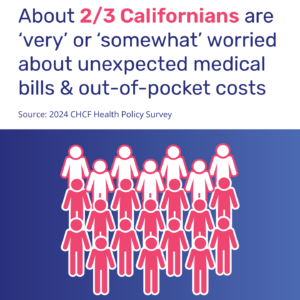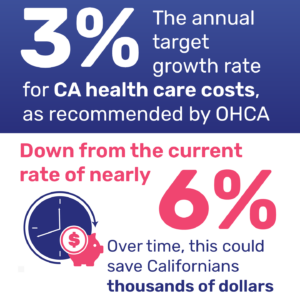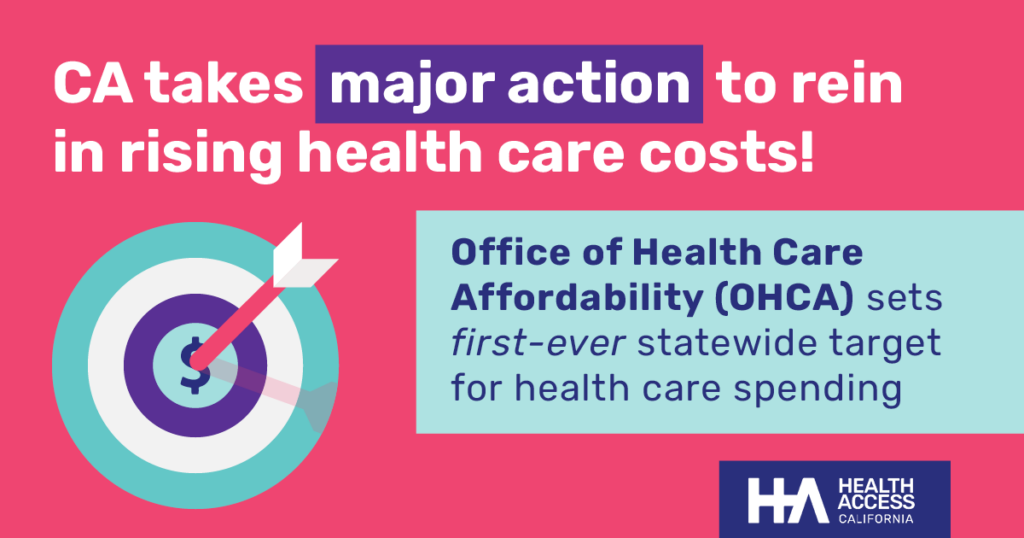CA Office of Health Care Affordability (OHCA)
In a big win for consumers facing ever-growing health care cost burdens, the Board of the Office of Health Care Affordability voted to set a 3% health care cost growth spending target over five years, with a phase-in starting at 3.5% in 2025. READ THE PRESS RELEASE
Health Care Costs are Too Damn High
 As Californians face an affordability crisis on many fronts, the cost of health care has been rising above inflation for years, taking larger and larger chunks out of workers’ wages and family finances. With median family coverage now costing an eye-popping $24,000 and the family share of employer coverage and deductible costing $10,600 or more, medical costs are a main driver in California’s affordability crisis. Nationwide, an average worker would have had $125,000 more in wages if not for inflated health care costs over the last three decades. Family incomes have climbed by 3% per year while premiums have gone up 5% and deductibles have risen 8% in California.
As Californians face an affordability crisis on many fronts, the cost of health care has been rising above inflation for years, taking larger and larger chunks out of workers’ wages and family finances. With median family coverage now costing an eye-popping $24,000 and the family share of employer coverage and deductible costing $10,600 or more, medical costs are a main driver in California’s affordability crisis. Nationwide, an average worker would have had $125,000 more in wages if not for inflated health care costs over the last three decades. Family incomes have climbed by 3% per year while premiums have gone up 5% and deductibles have risen 8% in California.
Health consumers are being forced to make tough decisions between paying for health care and affording other necessities like rent and food. This results in many Californians skipping or delaying the care they need – putting their health at risk. In the last year, more than half of Californians reported skipping or delaying health care due to the cost, and among those who skipped care, 46% say this made their condition worse.
 These high costs for health care disproportionately affect Black and Latino Californians who report they had problems paying or could not pay medical bills (36% and 40%, respectively, compared to White Californians at 20%)
These high costs for health care disproportionately affect Black and Latino Californians who report they had problems paying or could not pay medical bills (36% and 40%, respectively, compared to White Californians at 20%)
To address the rising cost of care the Legislature passed and Governor Newsom signed the 2022-23 state budget which created the Office of Health Care Affordability, within the Department of Health Care Access and Information (HCAI).
This new Office is charged with increasing price and quality transparency, developing specific strategies and cost targets for the different sectors of the health care industry, and will impose financial consequences for entities that fail to meet these targets. The ultimate goal is to have these savings be returned to consumers who are directly impacted by increasing health care costs.

And it’s already hitting the ground running. In January of this year, the staff of the Office of Health Care Affordability (OHCA) recommended setting the statewide cost growth target
at 3%, aligning with the average growth in median income. This means that health care costs will not grow more than what Californians can afford. Reducing growth rates will save Californians thousands of dollars over time.
Given the size and scale of the issue, as well as the solutions the Office could provide, it has a broad range of support from groups, including consumer, labor, business, health providers, and health care plans committed to working together to meet the goals of this newly established Office.
